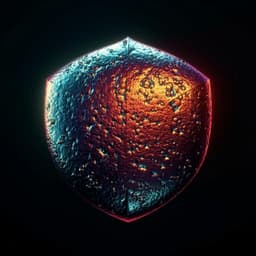
Space Sciences
Direct detection of atomic oxygen on the dayside and nightside of Venus
H. Hübers, H. Richter, et al.
Exciting advancements in Venusian atmospheric research have been achieved by Heinz-Wilhelm Hübers, Heiko Richter, Urs U. Graf, Rolf Güsten, Bernd Klein, Jürgen Stutzki, and Helmut Wiesemeyer. Their direct detection of atomic oxygen in both the dayside and nightside atmospheres at 4.74 THz opens new doors for understanding this enigmatic planet, concentrating around the 100 km altitude and influenced by CO2 and CO photolysis.
~3 min • Beginner • English
Introduction
The study addresses the long-standing challenge of directly detecting atomic oxygen (O) in Venus’s mesosphere and lower thermosphere, a key species for photochemistry and energy balance. Atomic oxygen is produced on the dayside by photolysis of CO2 and CO and transported to the nightside by subsolar-to-antisolar (SS-AS) circulation, where it can recombine to O2. Despite its importance as a tracer for global circulation and for CO2 15-µm cooling, prior observations of Venusian O were largely indirect, relying on O2 nightglow at 1.27 µm combined with photochemical models, or limited to the 557-nm night airglow (nightside only). The objective here is to demonstrate direct detection of O on both dayside and nightside using the ground-state fine-structure transition at 4.74 THz (63.2 µm), to quantify column densities and temperatures, and to examine spatial-temporal variations relevant to circulation in the 90–120 km region between the two dominant atmospheric flows.
Literature Review
Previous direct detection of atomic oxygen in Venus’s atmosphere was limited to the 557-nm green line night airglow, showing little variability across the disk on the nightside. Indirect nightside maps of O at 90–120 km were derived from VIRTIS/Venus Express O2(a1Δ) 1.27 µm nightglow, requiring global fields of O2 emission, CO2 density, temperature, and a photochemical model with assumed quenching coefficients, reaction rates, and efficiencies. These studies found atomic oxygen peaking near ~104 km at the antisolar point with 30–40% decreases away from midnight and towards ±30° latitude; model simulations show somewhat stronger decreases. The 4.74 THz line has been detected in Earth’s and Mars’s upper atmospheres; isotope ratios suggest Venus’s 16O/18O is similar to Earth’s (~500). Ground-based observations at these THz frequencies are impeded by telluric water vapor, necessitating airborne/spaceborne platforms. Prior far-IR/millimeter observations constrained Venus’s continuum brightness temperatures near 47–67 µm, with some reports of lower values possibly due to CO2 continuum absorption, though this remains debated.
Methodology
Observations: Atomic oxygen’s ground-state fine-structure 3P1→3P2 transition at 4.744777 THz (63.2 µm) was observed using the upGREAT array heterodyne spectrometer aboard SOFIA (2.5-m telescope). Flights occurred Nov. 10, 11, and 13, 2021 (1:45–2:30 UTC), with Venus at ~29″ apparent diameter and ~42% phase; geocentric velocity ~−13 km/s Doppler-shifted the Venus line by ~203–206 MHz from the telluric line, allowing separation. Telescope elevation was ~18.7°, leading to strong telluric absorption.
Instrument: upGREAT 4.7-THz high-frequency array (HFA) with seven HEB mixers in a hexagonal pattern (pixel separation 13.6″; beam FWHM 6.3″). Local oscillator: quantum-cascade laser. Backend: digital FFT spectrometer, 4.0 GHz bandwidth, 283 kHz resolution. Mixer SSB noise temperatures 2000–4000 K (0.5–4.0 GHz IF). Calibration: two blackbody loads, Thot=294 K and Tcold=149 K.
Observing strategy: The array was oriented roughly parallel to the terminator; nominal pointing on the brightness centroid of Venus, then rotated by 180° to compensate a 2.5″ central pixel offset and shift sampling by 5″. Pointing accuracy ~3.7″. Double beam switching at 0.6 Hz with 90″ throw; integration per on/off cycle 13.8 s; total on-source time per pixel varied due to limited visibility (~20 min/flight). The configuration placed the central pixel near ~15:00 LT on the dayside; some outer pixels sampled nightside or off-disk. In total, 17 positions were measured: 7 dayside, 9 nightside, 1 terminator.
Radiometric approach: The telluric O line was saturated at line center in both off- (sky) and on- (Venus) spectra. The saturated line center provides the Earth lower thermosphere brightness temperature (~196 K, from NRLMSISE-00), used for absolute calibration. The Venus continuum brightness temperature per pixel was derived by fitting the telluric line shape in the on-spectra with the Venus brightness temperature as a parameter, accounting for telescope–source coupling (efficiency 0.8) via beam–disk convolution.
Radiative transfer and retrievals: A line-by-line radiative transfer code (validated vs published codes at the 1% level) evaluates the 4.74 THz line radiance (step size 244 kHz) assuming LTE and negligible scattering. The monochromatic transmission τv=exp(−σv u) with σv=S·lineshape, pure Doppler broadening at these altitudes/pressures. Temperature dependence of line strength S is included via partition function scaling from S(296 K)=1.131×10−20 cm3 atom−1 cm2. For Venus, the model fits the observed absorption line against the continuum to retrieve the O column density and kinetic temperature per pixel. The Earth atmosphere (50–400 km) state for calibration was taken from NRLMSISE-00 at the flight times/locations.
Geometry and coverage: Local time coverage ~15:00–21:00 LT. Solar zenith angles span daytime to evening terminator and into nightside. Latitude sampling included near-equatorial (±10°), ~+35° N, and ~−25° S. Example equatorial dayside spectrum at 15:36 LT shows Venus O absorption at 4.744980 THz, separated by 203 MHz from the telluric line at 4.744777 THz. Table data around the equator include specific examples of brightness temperature, O temperature, and column density.
Key Findings
- First direct detections of atomic oxygen on both the dayside and nightside of Venus via the 4.74 THz ground-state transition; detected at all 17 sampled positions (7 dayside, 9 nightside, 1 terminator).
- Column densities range from 0.7 to 3.8 × 10^17 cm^−2 between ~15:00 and 21:00 LT, with higher values on the dayside where O is produced by photolysis of CO2 and CO. Example retrieval at 15:40 LT (dayside) yields (3.0 ± 0.5) × 10^17 cm^−2.
- Atomic oxygen temperatures: dayside average 156 ± 18 K; nightside average 115 ± 25 K. These are within the lower portions of previously reported ranges for 90–120 km altitudes and imply O is concentrated near ~100 km. Independent line-width estimates yield Doppler temperatures 180 ± 25 K (dayside; FWHM 11.8 ± 0.9 MHz) and 135 ± 45 K (nightside; FWHM 10.2 ± 1.6 MHz), consistent with the radiative transfer fits and confirming day > night temperatures.
- Venus continuum brightness temperature at 63 µm averages 246 ± 6 K, corresponding to altitudes just above the cloud tops (~65–70 km). A small, barely significant day–night difference is suggested: nightside 249 ± 6 K vs dayside 242 ± 4 K, possibly reflecting slight opacity differences.
- Daytime column density decreases modestly with increasing solar zenith angle (reduced photolysis) and near the terminator; nightside shows no clear trend within sampled LTs. A small local column density peak is observed around 19:00–20:00 LT, potentially due to dynamical effects, though much weaker than the expected antisolar maximum (not sampled here).
- Retrieved column densities are comparable to those inferred from O2 nightglow plus photochemical models (e.g., 3–6 × 10^17 cm^−2 with maxima at the antisolar point) and consistent with certain model predictions (e.g., ~2 × 10^17 cm^−2), while some global circulation/model combinations yield lower values (~1 × 10^17 cm^−2). Predicted small daytime latitudinal variations (∼10%) are broadly consistent with observations.
- The data do not support strong CO2 pressure-induced continuum absorption at ~60–63 µm implied by some prior work; measured brightness temperatures align with earlier far-IR determinations near these wavelengths.
Discussion
These measurements provide the first direct confirmation of atomic oxygen on both the dayside and nightside of Venus at mesospheric/lower thermospheric altitudes, addressing the prior reliance on indirect nightglow methods and models. The observed column densities and their modest daytime decline with solar zenith angle are consistent with photolytic production on the dayside and subsequent transport, with some recombination losses, toward the nightside. The temperatures derived for O, higher on the dayside than nightside, align with expected thermal structures near ~100 km and with Doppler-broadened linewidths, strengthening the interpretation that O is concentrated around the 90–120 km region that bridges the retrograde super-rotation and SS-AS flows.
Agreement of measured column densities with model predictions and with values inferred from O2 nightglow–based inversions lends confidence to photochemical-circulation frameworks, though the absence of coverage near the antisolar point precludes direct sampling of the strongest expected nightside maximum. The continuum brightness temperature results constrain the radiative environment near 63 µm and do not corroborate strong CO2 continuum opacity effects previously suggested at nearby wavelengths.
Methodologically, exploiting the Doppler shift to separate Venusian from telluric O and using the saturated telluric line for absolute calibration demonstrates a robust approach under challenging observing conditions. While the current SOFIA-based approach retrieves column densities integrated over the line of sight, a THz heterodyne spectrometer on a Venus orbiter could perform limb scans to deliver altitude-resolved O profiles, enabling more direct evaluation of circulation and photochemistry in the transition region.
Conclusion
The study demonstrates the first direct detections of atomic oxygen on both the dayside and nightside of Venus through observations of the 4.74 THz fine-structure line with SOFIA/upGREAT. It quantifies O column densities (0.7–3.8 × 10^17 cm^−2) and temperatures (∼156 K dayside, ∼115 K nightside), indicating concentrations near ~100 km and confirming expected day–night contrasts linked to photolysis and global circulation. The continuum brightness temperature near 63 µm (~246 K) corresponds to just above the cloud tops and does not indicate strong CO2-induced continuum absorption.
These results open a new observational window on the 90–120 km region that bridges Venus’s two dominant circulation regimes, providing ground truth for models and complementing prior nightglow-based inferences. Future work should target comprehensive coverage across solar zenith angles, especially the subsolar and antisolar points, and pursue altitude-resolved measurements from orbit to refine understanding of O production, transport, and loss, with implications for comparative planetology of Venus and Earth and for upcoming missions such as NASA’s DAVINCI and ESA’s EnVision.
Limitations
- Limited spatial and temporal coverage: observations span ~15:00–21:00 LT and do not include the antisolar point where the nightside maximum is expected; coverage is sparse in latitude.
- Observing constraints: low telescope elevation led to strong telluric absorption and short observing windows, impacting SNR and uniformity across pixels.
- Retrieval assumptions: LTE is assumed; scattering neglected; pressure broadening neglected (appropriate at these altitudes). Column densities are line-of-sight integrals rather than altitude-resolved profiles.
- Calibration/model dependence: absolute calibration relies on the saturated telluric line and NRLMSISE-00 Earth atmosphere; uncertainties in coupling efficiency and fitting contribute to error bars.
- The suggested day–night difference in continuum brightness temperature is marginal in statistical significance.
Related Publications
Explore these studies to deepen your understanding of the subject.







